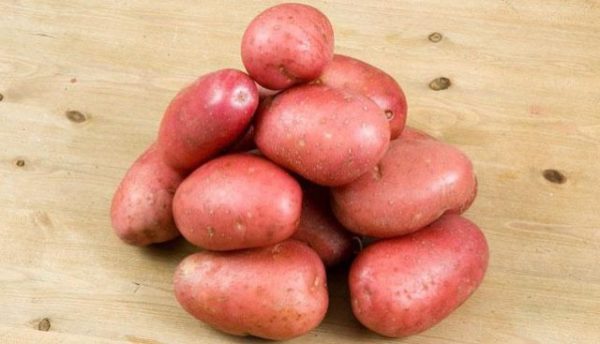
Thanks to the detailed description of the Zhuravinka potato variety (photo) and its reviews, summer residents and gardeners have the opportunity to learn more about the vegetable and its growing characteristics. According to farmers, this kind of plant has a high yield, excellent resistance to diseases and pests, and is well stored in winter.
In accordance with the description of the vegetable, Zhuravinka potatoes are usually classified as mid-season plant varieties. The ripening period of root crops is approximately 80-110 days from the moment of planting in the ground.
The genus of the plant is considered to be Belarus, where this variety was bred more than 10 years ago. After the vegetable began to be transported to many countries, including Russia. And now a decent period of time potatoes are grown in the fields and in private lands. Due to its advantages and high resistance to various diseases, such a vegetable is loved by many summer residents and gardeners.
Since the plant is not whimsical at all, it is grown in any locality and does not require careful maintenance. By itself, the Zhuravinka potato variety (photo) according to the description represents the following: the bushes are strong, straight, not tall. Leaves of medium size with brightly protruding veins and wavy along the edge. On one bush no more than 6 stems can grow.
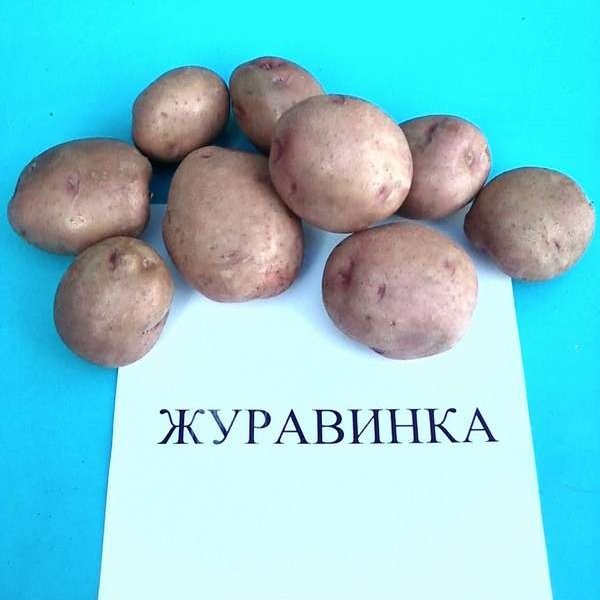
Potato inflorescences are large with purple petals. Berries with seeds are almost not formed. The first sprouts of the vegetable appear simultaneously, and the initial months grow intensively. Rapid formation is also characteristic of the root system and root crops.
Characteristics of Zhuravinka potatoes are determined by good productivity, resistance to diseases and pests, as well as their suitability for winter storage and unpretentious care for growing.
It is believed that the average vegetable yield ranges from 400 to 700 quintals.
The yield is stable annually, it does not depend on environmental conditions, the vegetable does not need special fertilizer and care, and is not afraid of mechanical stress.
The crane has high commercial qualities and is stored perfectly. The preservation of tubers is estimated at 96%, that is, only 4% of the total crop is susceptible to negative factors and spoilage. The rest of the potatoes survive the winter favorably and are perfectly preserved until spring and early summer, while not losing their taste and marketability.
Content
Potato Zhuravinka: yield, tubers, ripening
Potatoes Zhuravinka can be grown in various climatic conditions, the vegetable yield is very high. This explains the widespread prevalence of plants among summer residents and gardeners. But in order to achieve high growth of potatoes, it is necessary to observe a certain technology of cultivation, fight pests and diseases, properly fertilize the soil and conduct proper care.
According to the ripening time, for this type of potato it takes about 100 days to harvest. In certain territorial zones, such an indicator can reach up to 110 days. But due to the fact that the plant emerges together, the crop is uniform and always present.
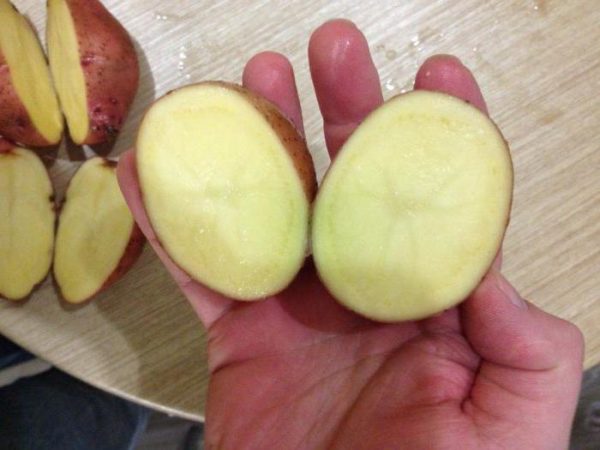
When harvesting potatoes, one bush may contain 15-20 large or medium tubers. By external signs, they are round or slightly elongated, the color is from pink to reddish. Dense peel of medium thickness.The surface is often hilly or smooth with a small mesh and evenly spaced eyes. Inside, the vegetable is light yellow, which allows you to digest well, but not turn into porridge. This is due to the high value of starch. In one tuber, its content can reach up to 20% or more.
Compliance with all the principles and technology of cultivation allows you to harvest a good crop in the summer. Often from one bush it turns out up to 2 kg of potatoes. Therefore, the Zhuravinka variety has a good distribution among private lands, as well as farmers. And excellent commodity, taste and excellent storage only increase the benefits of the plant.
Advantages and disadvantages
The positive qualities of Zhuravinka potatoes are:
- High plant resistance to various diseases and many types of pathogens.
- Well developed root system.
- Excellent resistance to mechanical stress.
- The vegetable is not afraid of temperature changes, it can feel comfortable at + 7 ° C to 40 ° C.
- Potato variety is not whimsical to care for.
- There is a high yield regardless of environmental conditions.
- When cooking, the vegetable is well boiled.
- Excellent taste.
The disadvantages of such a plant include:
- Dry climate intolerance.
- The development of diseases and possible rotting of the plant with excessive soil moisture.
Growing rules
From ordinary potatoes, the technology for growing Zhuravinka cultivars is almost no different. Although such a plant is unpretentious, you still need to follow certain principles and conduct proper care.
Achieving a high yield is easy enough, you just need to properly prepare the land, tubers and plant.
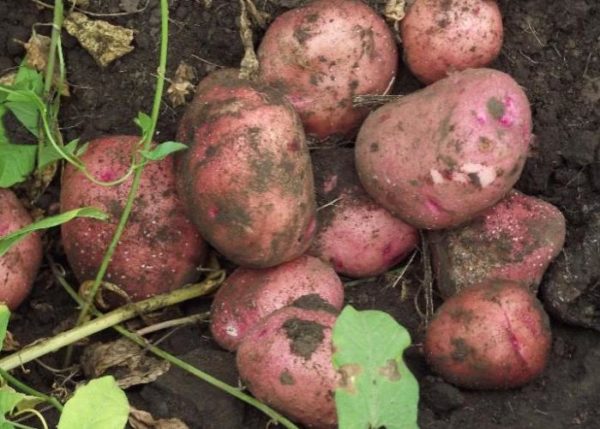
It is believed that the Zhuravinka potato variety is particularly demanding on various bacteria living in the soil, which contribute to the good growth and development of the vegetable. Therefore, digging up the soil and loosening the holes follows a special scheme:
- Throughout the territory allotted for the cultivation of potatoes, furrows are made. They are filled with grass, leaves and stems of plants. Top covered with brown coal of small size.
- The remaining, untouched place is dug up by a pitchfork to a depth of 15 cm.
- Fertilizing the vegetable is carried out directly during planting. To do this, add a little humus or harvested compost to the hole.
For planting potatoes, tubers are pre-selected. The best option is seed material weighing 30-100 g. To green the tubers and wait for the sprouts, they are placed in fresh air, where it is better to get light for 7-10 days. This must be done before harvesting the vegetable in the cellar to prevent mouse raids and the development of certain diseases.
Before planting potatoes into the soil, it is also advisable to hold them in the fresh air for 30-50 days, observing the temperature regime. Begin with 18 ° C, gradually reaching 4 ° C. This will harden the tubers and prepare them for planting in the ground.
The planting time of the Zhuravinka potato variety varies by region. So, in the western part of Russia, vegetable cultivation begins in early May, and in the southern regions, planting can begin in April.
For one potato bush, a plot should be allocated, with a distance of at least 30x30 cm. Therefore, between the neighboring holes, 20-30 cm recede, and between rows up to 50 cm.
Planting is carried out after soil preparation and the formation of holes. Since this potato variety does not tolerate drought, tubers are placed in the ground 10-12 cm deep. Planted vegetables at a temperature of 6-7 degrees and watered the area between the rows. By following such simple rules, it is possible to avoid the aridity of the earth and to grow a rich harvest.
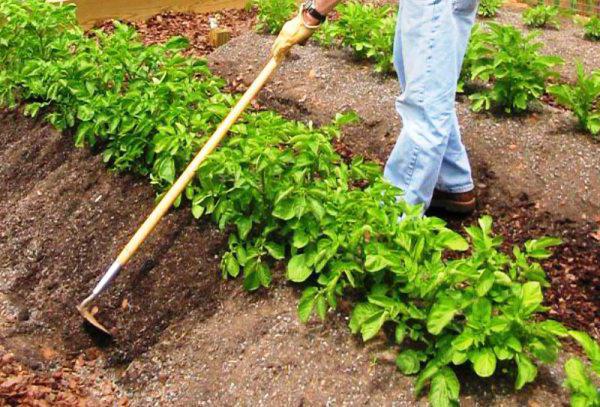
In each well, a tuber is placed with the sprout up, they are covered with soil from above and slightly harrowed the soil with a rake.
Care Rules
In order for potatoes to intensively grow and develop, it is necessary to provide him with proper care. To do this, you need to dig up the soil correctly, regularly water, weed the plants, hone the crop and fight pests.
Hilling potatoes Zhuravinka is recommended to start from the moment when the sprouts reach 15 cm in height. Using a chopper, the earth is thrown on the plant, forming a tubercle. In the process of hilling, the earth should also be weeded in parallel to the bushes.
Subsequent hilling is carried out before flowering, about 3 weeks before this moment.
Thanks to hilling, air circulation occurs, and the soil is saturated with oxygen, moisture is evenly distributed, preventing the development of diseases and decay.
Watering potatoes must be carried out with a certain technology, since the plant does not equally tolerate excess and lack of moisture. If for a long time the sediment is not observed, you need to water the bushes yourself in the morning and evening.
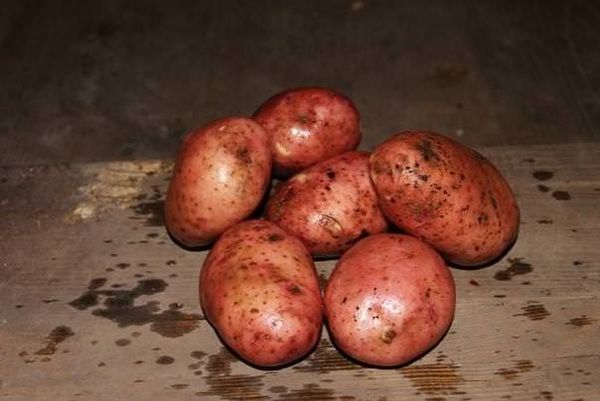
When, on the contrary, lingering and heavy rains appear, you should regularly weed and loosen the earth to prevent stagnation of the liquid, which leads to many diseases and decay of the plant.
Fertilizing during the growth period of the vegetable is also necessary. All top dressing is calculated based on 10 liters of water, they are carried out in stages:
- Before flowering potatoes - use urea (1 tbsp. L), 0.5 l is required per bush. Watered under the root system, avoiding contact with the upper part of the bush.
- During the formation of flowers - apply 1 tbsp superphosphate and a glass of ash. Pour 0.5 liters per potato bush.
- During the flowering period of plants - 1 tablespoon of superphosphate is bred into a bucket of water at the rate of 0.5 liters per bush.
Diseases and pests of the variety
Like other varieties of potatoes, Zhuravinka is also exposed to various pests and the development of diseases.
Among the common forms of diseases, the following are distinguished:
- Late blight - characterized by the development of white and brown spots on the leaves, stem and tubers. They tend to penetrate deep into potatoes, and it becomes inedible.
- Viruses - determined by dryness, yellowing of leaves. They fade, fall off. The bush itself ceases to grow and subsequently dies.
- Rhizoctonia is a common disease, has a fungal origin. It is characterized by rotting of the root system, dark spots appear on the leaves, stem, dry bush appears. Because of this, growth and development slows down, the plant dies.
- Basal rot - manifested by rotting of the root, as a result of which the bush dies.
Common pests of Zhuravink potatoes are the bear, the Colorado potato beetle, the wireworm and the field mouse. To prevent diseases and pests, it is important to properly care for, plant and store seed material.
Harvesting and storage
To preserve the harvest as much as possible, Zhuravinka potatoes should be harvested on time. As a rule, the collection of vegetables begins after the leaves of the plant fall; this occurs on the 20th of August.
After collecting the tubers, they are laid out on a flat surface, preferably with little access to sunlight, more spacious so that they dry out. And only then the potatoes are cleaned in the cellar in boxes or in a bag. Prior to harvesting in a street hole, it is recommended that the tubers be sorted into seed potatoes and small change in advance. Bad or punctured tubers are also assigned to the latter group.
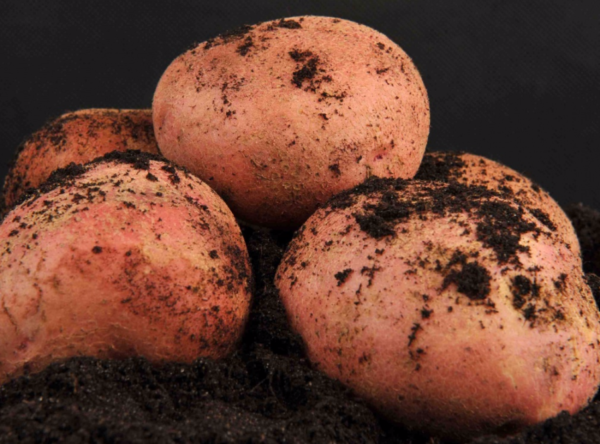
Reviews
Love, 42 years old:
“My family loves potatoes, so after years we have chosen Zhuravinka. “They are very happy with it, the tubers are large, even, the taste is wonderful and boils well.”
Oleg, 35 years old:
“Zhuravinka is very pleased with the potatoes, I especially like the fact that the variety has a high yield, is not afraid of temperature changes, is well stored in the winter and has excellent taste. And thanks to its high maturity and marketability, potatoes are selling well. ”
Alevtina, 56 years old:
“I love the crane very much. Her taste is just wonderful, so you can cook a lot of dishes. If you adhere to simple rules and recommendations for growing, you can collect a rich harvest. ”




 Description and description of varieties in Belarus with a photo
Description and description of varieties in Belarus with a photo Do I need to pick flowers from potatoes: why do they do it
Do I need to pick flowers from potatoes: why do they do it When to dig potatoes: timing and availability of new potatoes
When to dig potatoes: timing and availability of new potatoes How to grow a good potato crop: various methods and methods, planting and care
How to grow a good potato crop: various methods and methods, planting and care